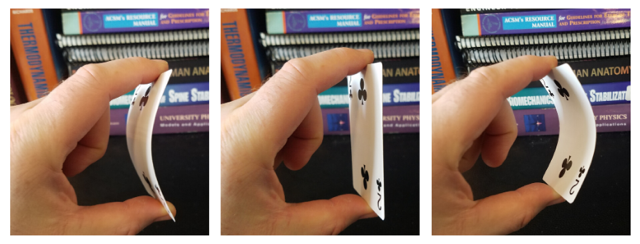
Have you ever wondered what causes a lifter’s legs to violently shake during a heavy deadlift? It doesn’t happen to all lifters, but it is a fairly common occurrence on heavy pulls. There’s a handful of theories as to why this happens and many of them have something to do with neuro-muscular issues arising at heavier weights. The brain somehow fails to send “clean” or “smooth” signals to the muscles and this is cause for an inefficient pull and much shaking – or so the conventional wisdom says. The reality is that a phenomenon called bifurcation of equilibria is largely responsible for the shaking of the legs, and more specifically, an oscillation of the knees during a max effort pull. The issue is more to do with the mechanical circumstances of the movement than a faulty mind-body connection.
Bifurcation of Equilibria Explained
To understand bifurcation of equilibria (plural of equilibrium) we must have a solid understanding of what equilibrium is. Equilibrium is simply a state of balance. All of the forces and moments acting on an object sum to zero, and therefore the object is not accelerating or changing with respect to velocity or momentum. Simple enough, right? Well, hang on, because there are three distinct states of equilibrium: stable, unstable, and neutral. These variations can be demonstrated by thinking of a ball sitting on a differently shaped surfaces. A ball resting in a valley is in stable equilibrium. If an external force moves the ball slightly up the incline away from the bottom of the valley it will roll back down and eventually settle at its original position once the external force is removed. A ball resting on top of a hill is in unstable equilibrium. If an external force pushes the ball off the top of the hill it cannot return to the original position without help from an additional external force. A ball resting on the flat surface is in neutral equilibrium. An external force acting on the ball will move it to a new point of equilibrium independent of the original position. So in summary, a stable equilibrium is a mechanically favorable position that will be returned to if left alone. An unstable equilibrium is a mechanically unfavorable position that cannot be returned to without help. And a neutral equilibrium is neither mechanically favorable or unfavorable. It is the ever-indifferent “meh” of the equilibria family.
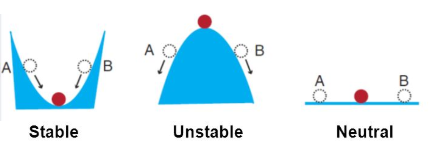
Once we understand the different possible states of equilibrium we can analyze mechanical systems with an eye towards determining if they’re likely to be stable, unstable, or neutral. And here’s a key point, many systems will have multiple possible positions of equilibria under a given set of conditions. We can demonstrate this with a simple example using a standard playing card. If you hold a single card on its ends between your forefinger and thumb and apply a very small amount of force the card will remain straight with the stiffness of the card resisting the compressive force from your finger and thumb indefinitely. At this point the system is in a state of neutral equilibrium. Apply just a little more forceand the card will be on the verge of buckling. The card is still straight, but is now in unstable equilibrium. Once it buckles the card will quickly and randomly bend to one side and form an arch shape. This arch shape is a neutral equilibrium, more balanced than the unstable middle position but still prone to disruption from an external force. Any deviation in the compressive force applied by your thumb and finger or any small amount of lateral force on the card may cause it to flip to the arch position on the opposite side. Hold the card just right and apply a small amount of lateral pressure with your off hand and you might even see it oscillate for a moment, flipping from one side to the other randomly while trying to settle into a more stable equilibrium. This is a classic example of bifurcation of equilibria. The card “jumps” from the unstable vertical position and will readily switch or bifurcate between the two neutral arch positions. As even more force is applied to the ends of the card it will settle into one of the arch shapes, bending to a smaller radius with the additional force exaggerating the curved shape. The deeper the arch becomes the more stable the position, and the less likely the card will flip back to the middle or other side without significant external interference.
Bifurcation of equilibria can be modeled using dynamical system mathematics, which not surprisingly is also prominent in chaos theory as well as several other complex system models. The mechanical phenomenon is observable in many other systems including structural beams and columns that buckle under heavy compressive and lateral loads, long driveshafts and propeller shafts that suddenly bend and “whirl” at certain rotational speed and torque loads, and fluid flow as it oscillates between a laminar and pre-turbulent flow state that precedes a transition to full turbulence 1. It’s also exactly what is happening as the knees begin to shake during the deadlift. A quick examination of the biomechanics at hand shows why.
Deadlift Mechanics
A truly heavy deadlift is a SLOW lift. The force applied to the bar will only marginally exceed the weight on the bar, otherwise it’s simply not that heavy. The bar breaks from the floor with a small bit of acceleration – just enough to get it moving, and from there it will maintain a near-constant upward velocity until it reaches lockout. Therefore, we can state that during a limit pull the entire mechanical system is operating at or near equilibrium through most of the range of motion. There’s a lot of force being applied to the bar, a lot or work being done against gravity, but not much acceleration to speak of. The forces at play are nearly in balance throughout the movement.
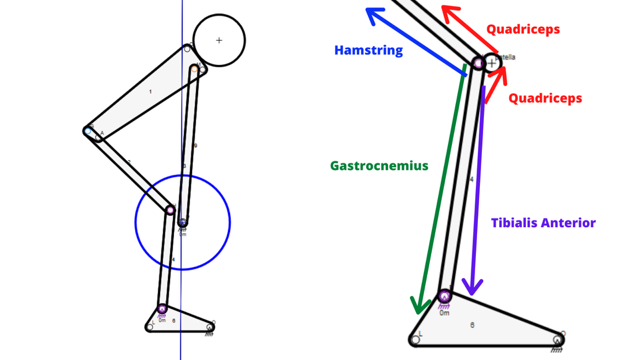
And despite the deadlift largely being thought of as a posterior chain exercise, the quadriceps get the party started and dominate the bottom half of the movement. The knees extend to break the weight off the floor with the hamstrings and gluteus muscles working to hold the back angle constant initially, and then gradually beginning to open the hips after the first couple inches of bar travel. By the time the bar has reached the bottom of the patella the knees are already most of the way extended while the hips are still flexed at around 90 degrees. A large amount of the force at the knee joint has thus been converted from moment to compressive force, with the hamstrings, quadriceps, and muscles of the shank still exerting some opposing lateral forces through the joint as well. And much like with the playing card example, the large compressive forces on the “structural column” of the leg combine with smaller lateral forces to create a very unstable equilibrium. And it’s at this point, bar just below the knees, where the lifter will begin to experience bifurcation of equilibria and start to shake.
Bifurcation of Knee Positions
The quads are fighting hard in an attempt to quickly and completely open the knees, and during a max pull they are working at or near their limit of force production. Reaching a point of full knee extension would mean the hardest work for the quads is over. They would only then need to hold the joint in extension while the hip extensors finish the job of dragging the bar the rest of the way up the legs. Full extension equals stable equilibrium, at least as far as the quads and the knee joint are concerned. As the bar travels higher and the knees get closer and closer to fully open, the more tempting it becomes to abandon the unstable (but mechanically imperative) bent knee position and allow the quads to finish the job by slamming the knees into full extension and locking them in place.
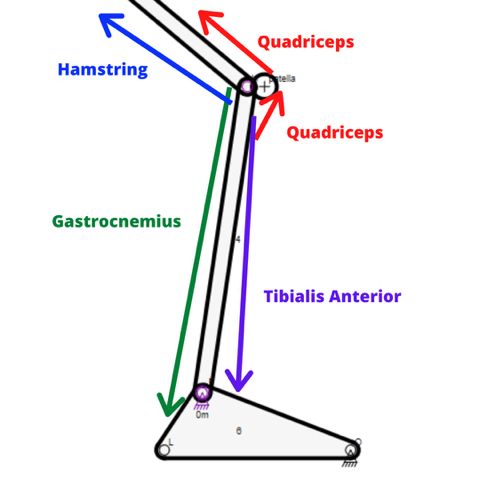
However, if full knee extension happens too early the hamstrings and glutes are left to do a lot of work from a now very un-advantageous position. In fact, extending the knees even just a little too early is basically a death sentence on any limit pull. The hips are pushed back and shoulders shoved significantly forward if the knees extend early. The back angle flattens out and increases the moment arm between bar and hip, thus increasing the moment load at the joint. Not good. The hamstrings, which anchor to the sides of the shank just below the knee, are stretched distally if the legs prematurely straighten, adding more tension and increased length to a muscle group that is also already at or near the limits of force production. The end result is less contractile force from the hamstrings acting against a now greater load at the hips. Again, not good. Ever try to Straight-Leg-Deadlift your Conventional Deadlift 1RM? How’d it go? Video or GTFO.
So while the quads are fighting for full knee extension as soon as possible, the hamstrings fight for the knees to stay in flexion, only allowing gradual extension as the bar travels up to lockout. This is the tug- of-war that causes the knees to violently shake – the bifurcation of equilibria between possible knee positions. The quads pull the knees open, the hamstrings pull them closed, and the knees swing like a pendulum through an inherent range of instability in the middle of the two positions.
It’s easy to see how fatigue and the very nature of a max pull contribute to the instability as well. If one or both of the muscle groups in question are at their force production limit, there is no strength reserve available to stabilize the correct movement pattern. And hence, we don’t see shaking on non-limit pulls.
A Case for Neuro-Muscular Casuality?
I believe bifurcation theory explains this phenomenon well, but there is also a possible case to be made for neuro-muscular disruptions bearing some partial responsibility as well. As the need for force- production ramps up the frequency of the action potentials from the brain to the motor units increases in kind. Eventually a physiological ceiling is encountered and all available motor units are firing at the highest possible frequency. The individual muscle cells don’t even have time to relax between pulses and the fibers enter a state of fused tetanic contraction. It’s not unreasonable to think that there would be random, transient disruptions in the mind-muscle connection during an event that requires this type of maximal contraction for any extended period. The amount of ATP in storage in the muscle cells limits a maximal force event like a deadlift to around ten seconds before force production rapidly begins to falloff, but we would expect there to be some amount of noise and minor disruption in the signaling mechanisms well before that, if not even right from the onset of maximal effort.
However, the neuro-muscular explanation cannot be the only explanation, and the reason why is mathematically simple. Research shows that the large muscle groups like the quads and the hamstrings tend to reach fused tetanus when the action potential reaches the maximum firing frequency around 50 Hz.2 Therefore we can say that all the motor units in the legs are firing around 50 times each second. The contractions are staggered between motor units to make for a smooth application of force, but in an instance of maximal contraction the signals overlap a good amount to thereby produce maximal force. Conversely, the shaking of the knees during the deadlift can be observed to occur very consistently at a nominal frequency around 5Hz. (Don’t ask how many crappy deadlifts I had to watch to formulate that data). In other words, if “the muscles are failing to fire” and causing the knees to oscillate back and forth, they’re doing so 5 times every second. So if we wanted to pin the shaking on a neuro-muscular failure we’d have to conclude that 1 out of every 10 action potentials was failing to create a muscular contraction (5Hz failure rate / 50 Hz signal rate). That’s a rather large failure percentage. In engineered we’d consider that an untenable noise to signal ratio. More importantly, that 10% failure rate would be accompanied by a 10% reduction in force production! And what happens when you suddenly start applying 540lbs to a 600lb barbell about the time it reaches your knees? That’s right, it unceremoniously returns to the floor rather quickly. So while it’s entirely possible that we’re losing some of the action potentials “in the noise” while operating at maximum effort, that alone is clearly not the main issue.
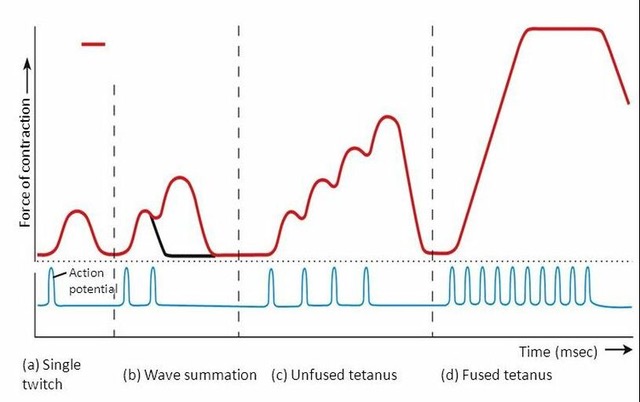
Photo courtesy of Wikipedia Commons: Twitch vs unfused tetanus vs fused tetanus, Daniel Walsh and Alan Syed, Sept 19, 2019
So How Do We Fix It?
As mentioned earlier, this phenomenon is an inherent mechanical outcome of the movement itself. There will be some cases that simply cannot be fixed and the lifter will have to deal with shaking on max pulls. However, proper movement timing will help the lifter avoid the dreaded shakes as much as possible. Specifically, one should be patient with knee extension especially when the bar is still below the knees, and likewise, patience with hip extension after the bar passes the knees is also key. Coach and lifter alike should compare slow-motion video of limit pulls to non-limit pulls and note any timing that looks different between the movements. Rushing to extend the knees or hips too early very well may indicate weakness in a given muscle group, as we tend to “cheat” to give the weak area any advantage we can. If this is found to be the case, the weakness should be addressed in a logical way applying progressive training stress that allows the weak muscle group to be strengthened as a functioning part of the greater movement pattern. Sub-maximal, isolative “corrective exercises” are a waste of time (and that’s a Bill Been article for another time).Shoving the knees out harder during the setup and bottom half of the pull can help as well. Not only will this allow the adductors to aid in the initial hip extension, but the additional external rotation forces can help stabilize the knees to a small degree. And during a max pull, we’ll take any and all help we can get.
1. Thorne, K. S., & Blandford, R. D. (2017). Modern classical physics optics, fluids, plasmas,
elasticity, relativity, and statistical physics. Princeton and Oxford: Princeton University Press.
2. Purves, D., Augustine, G. J., Fitzpatrick, D., Hall, W. C., LaMantia, A.-S., Mooney, R. D., … White,
L. E. (2019). Neuroscience. New York: Oxford University Press.

